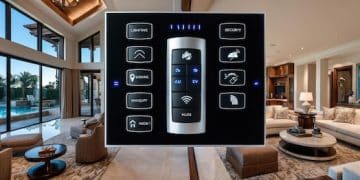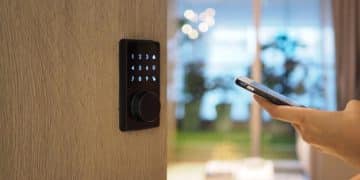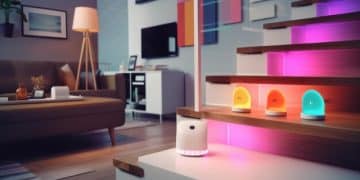Smart Home Control Panels: The Ultimate Centralized Interface for Your Devices
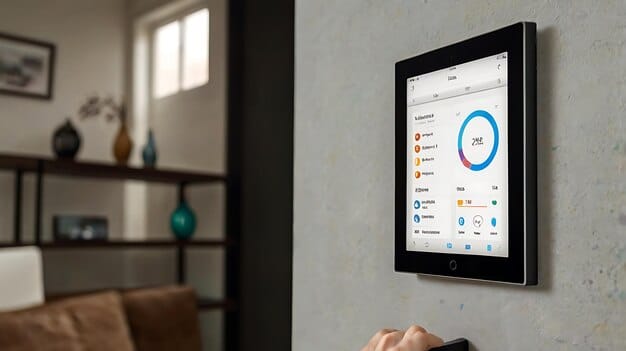
Smart home control panels offer a centralized interface to manage and automate various smart devices, providing convenience and enhanced control over your home’s systems, enhancing efficiency and user experience.
Imagine controlling all your smart home devices—lights, thermostats, security cameras, and more—from a single, intuitive interface. That’s the power of smart home control panels. In this article, we’ll explore how these panels can simplify your life and bring a new level of convenience to your connected home.
Understanding Smart Home Control Panels
Smart home control panels act as the central hub of your smart home ecosystem. Instead of juggling multiple apps and interfaces, a control panel consolidates everything into one easy-to-use system. This simplifies control and automation, making your smart home more accessible and enjoyable.
What is a Smart Home Control Panel?
A smart home control panel is a device that allows you to manage and interact with all your connected devices from a single point. These panels typically feature a touchscreen interface and are often mounted on a wall or placed on a tabletop. By integrating with various smart devices via Wi-Fi, Bluetooth, or other protocols, they provide a unified control experience.
Benefits of Using a Smart Home Control Panel
Centralizing your smart home devices offers numerous advantages. One key benefit is the ease of use. Instead of switching between different apps on your smartphone or tablet, you can control everything from a single screen. This is particularly beneficial for family members who may not be as tech-savvy or prefer a more straightforward approach to managing their smart home.
- Simplified Control: Manage all your devices from one interface.
- Enhanced Convenience: Easily adjust settings and automate tasks.
- Improved Accessibility: Makes smart home tech user-friendly for everyone.
A smart home control panel streamlines the entire smart home experience by eliminating the need to use multiple apps, reducing the time and effort needed to manage and interact with your devices.
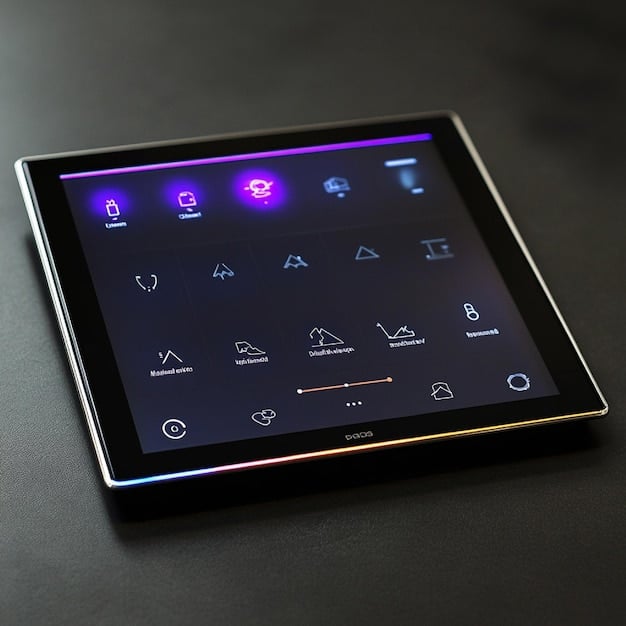
Key Features to Look for in a Smart Home Control Panel
Not all smart home control panels are created equal. When choosing a panel for your home, it’s important to consider several key features to ensure it meets your specific needs and provides a seamless user experience. These features can greatly enhance the functionality and usability of your smart home system.
Compatibility with Existing Devices
One of the most crucial factors is compatibility. Ensure the control panel supports the smart devices you already own or plan to purchase in the future. Look for panels that support popular protocols like Wi-Fi, Zigbee, Z-Wave, and Bluetooth. Compatibility ensures that your devices can communicate effectively with the panel.
User Interface and Customization
The user interface (UI) should be intuitive and easy to navigate. A well-designed UI will make it simple to find and control your devices. Customization options are also important, allowing you to tailor the panel to your preferences. For example, you may want to rearrange the icons, create custom scenes, or adjust the color scheme.
- Intuitive UI: Easy navigation and device control .
- Customizable Layout: Personalize the panel to suit your needs.
- Voice Control Integration: Hands-free operation with voice assistants.
Choosing a control panel with a solid blend of compatibility, intuitive design and customization options ensures that users get the most value and ease from their smart home setup.
Installation and Setup of Smart Home Control Panels
Setting up a smart home control panel can range from a simple plug-and-play process to a more involved installation. Understanding the different installation methods and required steps will help you choose the right panel and ensure a smooth setup. Proper installation is crucial for optimal performance.
Wired vs. Wireless Options
Smart home control panels come in both wired and wireless configurations. Wired panels typically require professional installation, as they need to be connected to your home’s electrical system. Wireless panels, on the other hand, are generally easier to install, as they run on battery power or plug into a standard outlet. Consider the complexity and convenience of each option when making your decision.
Step-by-Step Setup Guide
The setup process usually involves connecting the panel to your home’s Wi-Fi network and then pairing it with your smart devices. Many panels come with a mobile app that guides you through the setup process step by step.
- Connect to Wi-Fi: Establish a stable network connection.
- Pair Devices: Link your smart devices to the control panel.
- Customize Settings: Configure preferences and automation.
By following a few simple steps and understanding the wired and wireless options available, setting up a smart home control panel can be a streamlined process, bringing you closer to a truly connected home.
Integrating Smart Home Control Panels with Other Devices
The true power of a smart home control panel lies in its ability to integrate seamlessly with a wide range of smart devices. This integration allows you to create complex automations and control your entire home from one central location. The more devices you can integrate reliably, the more comprehensive and convenient your smart home becomes.
Lighting and Temperature Control
One of the most common uses of a smart home control panel is to control lighting and temperature. You can use the panel to adjust the brightness of your lights, set schedules for turning them on and off, and even create custom lighting scenes for different occasions. Similarly, you can adjust your thermostat to maintain a comfortable temperature in your home.
Security and Surveillance
Smart home control panels can also be integrated with security cameras, door locks, and alarm systems. This allows you to monitor your home’s security from a central location.

- Security Monitoring: View camera feeds and lock doors remotely.
- Automation: Set up automated routines based on triggers.
- Voice Control: Operate devices using voice commands.
Smart integration of lighting, temperature controls, and security systems not only provides convenience and comfort, but enhances overall home security.
Troubleshooting Common Smart Home Control Panel Issues
Even with the best smart home control panels, you may encounter occasional issues. Knowing how to troubleshoot these common problems can save you time and frustration, ensuring that your smart home system runs smoothly. Addressing issues promptly maintains your home’s automation and control.
Connectivity Problems
One of the most common issues is connectivity problems. If your control panel is not connecting to your Wi-Fi network or your smart devices, there are several things you can try.
Device Compatibility Issues
Sometimes devices may not be compatible due to outdated firmware or protocol differences. Check for updates regularly.
- Reboot Devices: Restart the control panel and connected devices.
- Check Firmware Updates: Ensure all devices have the latest software.
- Reset Network Settings: Reconfigure Wi-Fi and device connections.
By addressing connectivity and compatibility issues promptly, problems can be solved early on, keeping the smart home running smoothly without long downtimes.
The Future of Smart Home Control Panels
The future of smart home control panels looks promising, with advancements in technology and increasing integration with other smart devices. As technology evolves, these panels will become even more sophisticated and user-friendly. Staying informed about these future trends helps users make informed decisions when investing in smart home technology.
Advancements in Technology
One of the key trends to watch is the integration of artificial intelligence (AI) and machine learning (ML). AI-powered control panels will be able to learn your habits and preferences, automatically adjusting settings to suit your needs. For example, the panel could learn your preferred lighting and temperature settings for different times of the day and automatically adjust them accordingly.
Enhanced User Experience
Future smart home control panels will also offer a more personalized user experience. This could include features like facial recognition, which allows the panel to identify different users and automatically load their preferred settings. Enhanced voice control capabilities will also play a significant role, making it easier to interact with your smart home using voice commands.
- AI Integration: Learning user habits for automated adjustments.
- Facial Recognition: Personalized settings for different users.
- Enhanced Voice Control: Easier interaction with voice commands.
The future of smart home control panels points towards a more automated, personalized, sophisticated approach to managing smart home devices.
| Key Point | Brief Description |
|---|---|
| 🏠 Centralized Control | Manage all smart devices from one panel. |
| ⚙️ Compatibility | Ensure the panel supports your existing and future devices. |
| 🔑 Key Features | Look for intuitive UI, customization, and voice control. |
| 💡 Future Trends | AI integration and enhanced user experience. |
Frequently Asked Questions
A smart home control panel is a central device used to manage and automate all connected smart devices within a home from a single interface, providing ease and convenience.
Consider compatibility with your existing devices, ease of use, customization options, and future-proofing features to ensure it fits your smart home needs.
Yes, by integrating with security cameras, door locks, and alarm systems, control panels allow you to monitor and manage your home’s security from one central location.
Control panels offer both wired and wireless installation options; wired versions typically require professional installation, while wireless options are easier to set up on your own.
Future trends include the integration of AI for automated adjustments, facial recognition for personalized settings, and enhanced voice control capabilities for easier interaction.
Conclusion
Smart home control panels offer a convenient and efficient way to manage and automate your connected devices. By centralizing control, they simplify your smart home experience and enhance your overall quality of life. As technology continues to evolve, these panels will become even more powerful and user-friendly, making them an essential component of any modern smart home.
